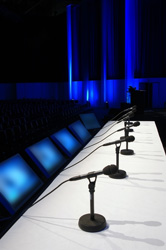Science for the public
Often science and research are perceived as 'difficult' areas by the general public; exposure is generally limited to the announcements of occasional breakthroughs or discoveries via the mass media. With so much ongoing research and development, Europe has long sought to bridge the gap between public knowledge and science. One such initiative being reproduced in many European countries is the European Researchers' Night, which creates festive, engaging events to present and demystify science projects undertaken by a country's researchers. In this light, on 25 September 2009, the EU-funded 'Belgian researchers animating sport and innovation links' (Brasil) project organised several such events in eight cities across Belgium: Brussels, Ghent, Kortrijk, Liège, Louvain-la-Neuve, Mechelen, Namur and Redu-Transinne. The events and activities included demonstrations, presentations and engaging means to unveil some of the latest scientific research going on in the country. To achieve this goal, nine partners came together under the coordination of the Belgian Science Policy Office with six universities, one high school, and the non-profit Flanders Technology International. The latter hosted science activities at Technopolis in Mechelen, while a private body, Créaction, hosted activities at the Euro Space Center in Redu-Transinne. In parallel, different universities and colleges across the country cooperated to make the event a success. Each partner defined its own programme of activities and launched its own publicity campaign through local newspapers and radio stations among other media, under the project's common template. The overall programme of activities was varied, comprising games, quizzes, interactive experiments, demonstrations, on-site discoveries and guided tours. All activities offered the audience an opportunity to directly meet researchers and discuss any topic, whether linked to science or not. In addition to all these activities, a poster contest was organised, inviting budding artists to create posters for the Researchers Night 2010. Posters were collected and displayed in all the venues, and winners of the competition were announced just after the 2009 event. The Brasil project enhanced public recognition of the researchers' work and their role in society, communicating the importance of scientific research to the public at large. It offered a wide audience the opportunity to get close to researchers, not only in their professional environment but also in everyday situations where they could show their 'human side'. Overall, the project built trust between the public and science, enlightening people about scientific projects in engaging ways. The event can certainly be seen as a success in achieving its goals and can be used as a model for similar initiatives in other countries.



